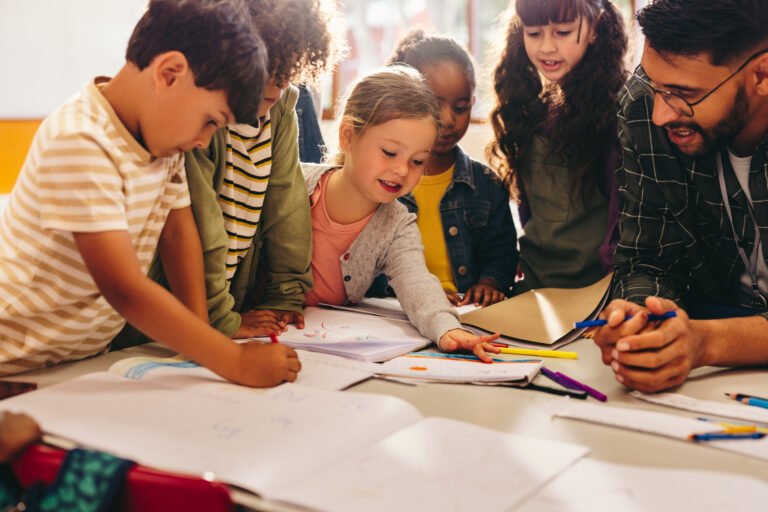
Teaching children emotional regulation involves modeling healthy behaviors, encouraging open discussions about feelings, and developing coping strategies through activities, fostering their ability to manage emotions effectively.
Emotional regulation is essential for fostering resilience in children, especially those who are gifted or neurodivergent. How can we effectively support them?
Understanding emotional regulation
Understanding emotional regulation is crucial for helping children, especially those who are gifted or neurodivergent. It involves recognizing, controlling, and expressing emotions appropriately. Children often experience intense feelings that can be overwhelming.
What is Emotional Regulation?
Emotional regulation refers to the ability to manage one’s emotional experiences. This includes being aware of emotions, having the capacity to calm oneself, and knowing how to express feelings in a constructive way.
The Role of Emotions in Development
Emotions are an essential part of human experience and play a significant role in decision-making, learning, and social interactions. For children, learning to regulate emotions is vital for their growth and development.
Why is Emotional Regulation Important?
Effective emotional regulation can lead to better social skills and academic performance. Children who can manage their feelings tend to handle stress better and form healthier relationships.
Signs of Difficulties in Emotional Regulation
Some signs that a child struggles with emotional regulation include frequent outbursts, difficulty focusing, or withdrawing from activities and people. Recognizing these signs is a first step in providing support.
Helping Children Understand Their Emotions
One way to promote emotional regulation is to help children label their feelings. Encouraging them to talk about their emotions can empower them to manage their responses effectively.
The importance of emotional awareness
The importance of emotional awareness cannot be overstated, especially for children who are gifted or neurodivergent. Emotional awareness is the ability to recognize and understand one’s own emotions and the emotions of others.
What is Emotional Awareness?
Emotional awareness involves noticing emotions as they occur. It helps children to identify feelings like happiness, sadness, anger, and frustration, making it easier for them to express these emotions in healthy ways.
Benefits of Being Emotionally Aware
When children are emotionally aware, they can better manage their reactions. This leads to improved relationships with peers and adults, better decision-making skills, and enhanced overall emotional health.
Recognizing Emotions
Teaching children to recognize emotions can start with simple activities, such as using pictures of faces to identify feelings. This practice can help them connect emotions to situations they encounter.
Expressing Emotions Effectively
Emotional awareness allows children to express their feelings in a constructive manner. Instead of having outbursts, they can learn to communicate what they are feeling and why, which is crucial for effective problem-solving.
Emphasizing Empathy
Being aware of one’s own emotions also fosters empathy for others. Children who understand their feelings are more likely to recognize the emotions in their peers, leading to kinder interactions and stronger friendships.
Identifying big feelings in children
Identifying big feelings in children is a crucial part of helping them manage their emotions. Children often experience intense feelings that can be difficult to articulate. Recognizing these feelings early can make a significant difference in their emotional development.
Understanding Big Feelings
Big feelings can range from joy and excitement to anger and sadness. These emotions can overwhelm children, leading to tantrums or withdrawal. It’s important for adults to validate these feelings rather than dismiss them.
Common Signs of Big Feelings
Children may express big feelings in various ways. For example, they might cry, shout, or become overly clingy. Physical signs like a racing heart, sweating, or trembling can also indicate they are feeling overwhelmed.
Using Emotions Vocabulary
Teaching children to use an emotions vocabulary can help them articulate their feelings. Use charts with facial expressions or emotion cards to encourage children to name what they feel. This practice empowers them to express themselves.
Observing Behavior Changes
Changes in a child’s behavior can signal the presence of big feelings. If a typically cheerful child suddenly becomes withdrawn or angry, it’s essential to check in and find out what might be causing this shift.
Promoting Open Communication
Creating a safe space for children to talk about their feelings can greatly benefit their emotional health. Encourage them to share their thoughts without judgment, reinforcing that it’s okay to feel their emotions.
Practical strategies for managing emotions
Managing emotions effectively is essential for children, particularly those who are gifted or neurodivergent. Practical strategies can equip them with the tools they need to navigate their feelings more easily.
Deep Breathing Techniques
One of the simplest techniques for managing emotions is deep breathing. Encouraging children to take slow, deep breaths can help calm overwhelming feelings. Teach them to inhale deeply through their nose and exhale slowly through their mouth.
Creating a Calm Down Space
Designating a calm down space in the home can provide children with a safe area to retreat when they feel overwhelmed. This space should be cozy and include calming items like soft pillows, books, or sensory toys.
Using a Feelings Journal
A feelings journal can be a valuable tool for children to express their emotions. Encourage them to write or draw about what they feel each day. This practice helps them process their emotions and fosters emotional awareness.
Role-Playing Different Scenarios
Role-playing can prepare children for emotional situations they might encounter. You can simulate everyday scenarios like sharing toys or resolving conflicts, allowing them to practice their responses in a supportive environment.
Incorporating Physical Activity
Physical activity can be a great way for children to manage emotions. Activities like running, dancing, or yoga can help release pent-up energy and improve mood. Encourage regular physical play to help them feel more balanced.
Creating a supportive environment at home
Creating a supportive environment at home is essential for children’s emotional well-being, especially for those who are gifted or neurodivergent. A nurturing space can significantly impact their ability to manage emotions effectively.
Establishing Open Communication
Encourage open communication by letting children express their thoughts and feelings without fear of judgment. Listening actively to their concerns helps build trust and strengthens your relationship.
Setting Clear Routines
Clear routines provide children with a sense of stability and predictability. Knowing what to expect helps reduce anxiety and empowers them to manage their emotions more effectively.
Creating a Calming Atmosphere
Incorporate calming elements into your home, such as soft lighting, soothing colors, and comfortable furnishings. A serene environment can help children feel safe and relaxed, making it easier for them to process their emotions.
Encouraging Independence
Allowing children to have some autonomy fosters confidence in their decision-making abilities. Encourage them to take on age-appropriate tasks and let them explore their interests, which can be empowering.
Providing Emotional Support
Be available to provide emotional support when needed. Let children know that it’s okay to feel overwhelmed sometimes and that they can always come to you for comfort and guidance.
Using calming tools and techniques
Using calming tools and techniques can greatly benefit children in managing their emotions. These strategies help to create a sense of peace and can be useful during overwhelming moments.
Essential Oil Diffusers
Aromatherapy can be a powerful calming tool. Using an essential oil diffuser with scents like lavender or chamomile can create a soothing atmosphere. These scents are known to promote relaxation and stress relief.
Weighted Blankets
Weighted blankets provide gentle pressure that can help children feel secure and calm. They are particularly beneficial for those who experience anxiety. A weighted blanket can make bedtime or quiet time much more comforting.
Mindfulness and Meditation Apps
There are many apps available that guide users through mindfulness exercises and meditation. These practices encourage children to focus on their breath and stay present, which can reduce feelings of anxiety and stress.
Fidget Tools
Fidget tools, like stress balls or fidget spinners, can help children release excess energy and anxiety in a simple way. These tools give them a way to manage their feelings while staying engaged.
Visualization Techniques
Teaching children visualization techniques can help them calm their minds. Encourage them to imagine a peaceful place or a favorite memory when they start to feel overwhelmed. This practice can help reduce anxiety and bring a sense of tranquility.
Encouraging open discussions about feelings
Encouraging open discussions about feelings creates a supportive environment where children feel safe to express their emotions. This practice is crucial for their emotional development, especially for gifted and neurodivergent kids.
Creating a Safe Space
It’s important to create a safe space for children to share their feelings without fear of judgment. Let them know that all emotions are valid. This helps build trust and encourages them to open up.
Using Open-Ended Questions
Ask open-ended questions to prompt discussions. For example, try asking, “How did that make you feel?” or “What do you think about that situation?” This encourages children to elaborate on their feelings.
Sharing Personal Feelings
Modeling emotional openness by sharing your feelings can be very effective. When children see adults openly discussing their emotions, they may feel inspired to do the same. Share how you handle various emotions in a relatable way.
Incorporating Literature and Media
Using books and movies to discuss emotions can also be beneficial. After reading a story or watching a movie, ask them how the characters might be feeling and why. This helps children relate their own emotions to those of others.
Establishing Regular Check-Ins
Set aside time for regular emotional check-ins. Create a routine where children can express how they feel on a daily or weekly basis. This promotes a habit of discussing emotions openly and regularly.
Modeling emotional regulation for kids
Modeling emotional regulation for kids is an essential step in teaching them how to manage their own feelings. Children often learn by observing their parents and caregivers, making it important to demonstrate healthy emotional practices.
Demonstrating Calmness
When faced with stressful situations, show children how to respond calmly. Take deep breaths, speak softly, and practice patience. This encourages them to mimic these behaviors when they encounter their own challenges.
Verbalizing Emotions
Use everyday experiences to discuss emotions. Share how you feel in various situations and explain how you cope. For example, saying, “I felt frustrated when I lost my keys, so I took a moment to breathe and think,” helps children connect with their own feelings.
Using Positive Language
Model positive language when discussing emotions. Instead of saying, “I’m angry,” try framing it as, “I feel upset, but I can handle it.” This teaches children that it’s okay to feel upset but also shows them how to express emotions constructively.
Practicing Problem-Solving
When problems arise, involve children in the problem-solving process. Discuss potential solutions and allow them to see how to navigate emotions effectively. This involvement fosters their own skills in regulating feelings.
Applauding Their Efforts
When children attempt to manage their emotions, recognize and praise their efforts. Saying things like, “I’m proud of you for telling me how you felt,” reinforces their attempts to express and regulate emotions.
Developing coping strategies through activities
Developing coping strategies through activities can empower children to manage their emotions better. Engaging in various activities provides them with healthy outlets for expressing and regulating feelings.
Creative Arts and Crafts
Encourage children to engage in creative arts and crafts. Activities like drawing, painting, or sculpture can help them express their emotions visually. Art can be a calming practice, allowing them to channel feelings into something tangible.
Physical Exercise
Physical activity is a powerful coping strategy. Sports, dancing, or simple outdoor play help release endorphins, which can improve mood and reduce stress. Encourage children to find an activity they enjoy and make it a regular part of their routine.
Mindfulness Activities
Introduce mindfulness activities such as yoga or guided meditation. These practices teach children to focus on the present moment, helping them learn to manage stress and anxiety effectively. Use apps or videos designed for kids to make it fun and engaging.
Role-Playing Games
Role-playing can enhance emotional understanding and problem-solving skills. Create scenarios where children can act out different emotions and responses. This practice allows them to explore feelings in a safe space, fostering empathy and self-awareness.
Nature Walks and Outdoor Exploration
Spending time in nature can be incredibly therapeutic. Encouraging children to go for nature walks allows them to clear their minds and connect with their surroundings. Observing nature helps them ground themselves and appreciate the world around them.
Celebrating small wins in emotional growth
Celebrating small wins in emotional growth is vital for encouraging children to continue developing their emotional regulation skills. Recognizing progress, no matter how minor, builds confidence and reinforces positive behavior.
Importance of Acknowledgment
When children succeed in managing their emotions, it’s essential to acknowledge their achievements. Praising them for recognizing their feelings or calming down during a difficult moment can motivate them to keep trying.
Creating a Recognition Ritual
Establish a ritual for recognizing small wins. This could be a special family celebration, a sticker chart, or simply verbal praise. This practice makes it clear that every step forward in emotional growth is valued.
Share Stories of Success
Encourage children to share their own stories of success. Whether they managed a tough emotion or were kind to a friend, sharing these experiences helps them feel proud and motivates them to act similarly in the future.
Learning from Setbacks
It is also important to frame setbacks as learning opportunities. Discuss what could be done differently next time and celebrate the effort they put forth, even if the outcome wasn’t perfect. This helps children understand that growth is a process.
Encouraging Reflection
Encourage children to reflect on their emotional experiences. Ask questions like, “What made you feel good today?” or “How did you handle that situation?” This reflection helps them recognize their emotional growth and reinforces positive behavior.
Supporting Emotional Growth in Children
Helping children develop emotional regulation skills is essential for their well-being. By encouraging open discussions about feelings, modeling healthy behaviors, and celebrating small wins, we can create a supportive environment.
Implementing practical strategies such as creative activities and physical exercises can empower children to manage their emotions better. Remember to acknowledge their efforts and frame setbacks as opportunities for learning. This approach fosters resilience and helps them grow emotionally.
With the right support and guidance, children can learn to navigate their feelings confidently, leading to happier and healthier lives.
FAQ – Frequently Asked Questions About Supporting Children’s Emotional Growth
Why is it important to model emotional regulation for children?
Modeling emotional regulation teaches children how to handle their own feelings. They learn by observing adults, so showing healthy emotional practices helps them develop these skills.
How can I encourage open discussions about feelings with my child?
Create a safe space where your child feels comfortable sharing their feelings. Use open-ended questions to prompt discussions and validate their emotions.
What are some activities to develop coping strategies for managing emotions?
Activities like arts and crafts, physical exercise, role-playing, and mindfulness practices can help children develop healthy coping strategies.
How can I celebrate my child’s emotional growth?
Acknowledge their efforts in managing emotions, create rituals for recognizing small wins, and encourage them to share their successes in handling emotions.
What should I do if my child struggles with setbacks in emotional regulation?
Frame setbacks as learning opportunities. Discuss what could be done differently and reassure them that growth is a process that often includes ups and downs.
How can reflecting on emotional experiences benefit my child?
Encouraging reflection helps children recognize their emotional patterns and understand their feelings better. It reinforces positive behavior and boosts their emotional intelligence.

A certified Heal Your Life® Coach with 20+ years in education and emotional development. Supports gifted teens in navigating anxiety, perfectionism, and identity challenges, while equipping parents with practical tools for lasting transformation. Sessions blend emotional healing, mindset mastery, and strategic empowerment.



